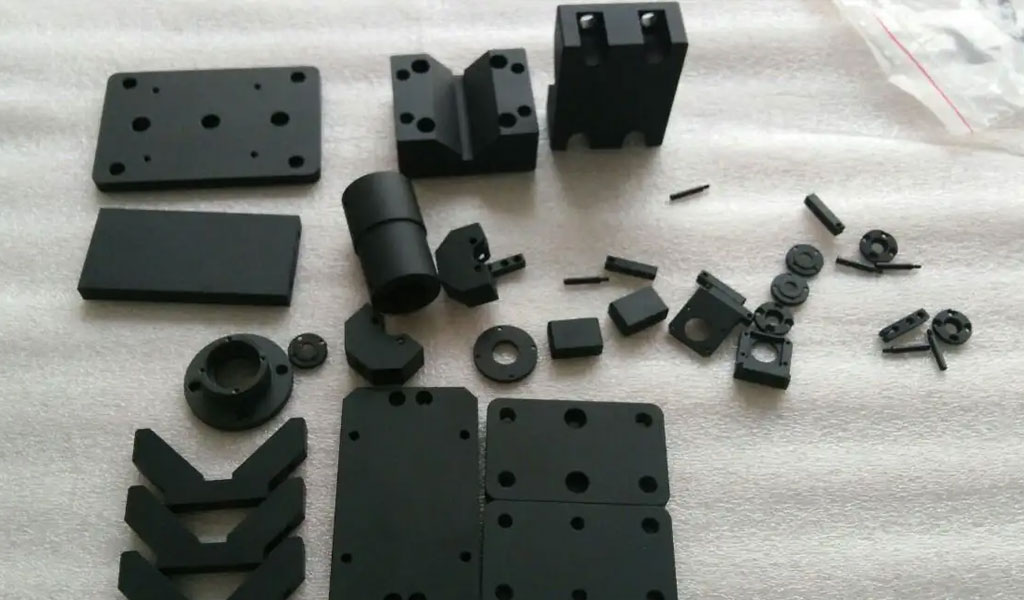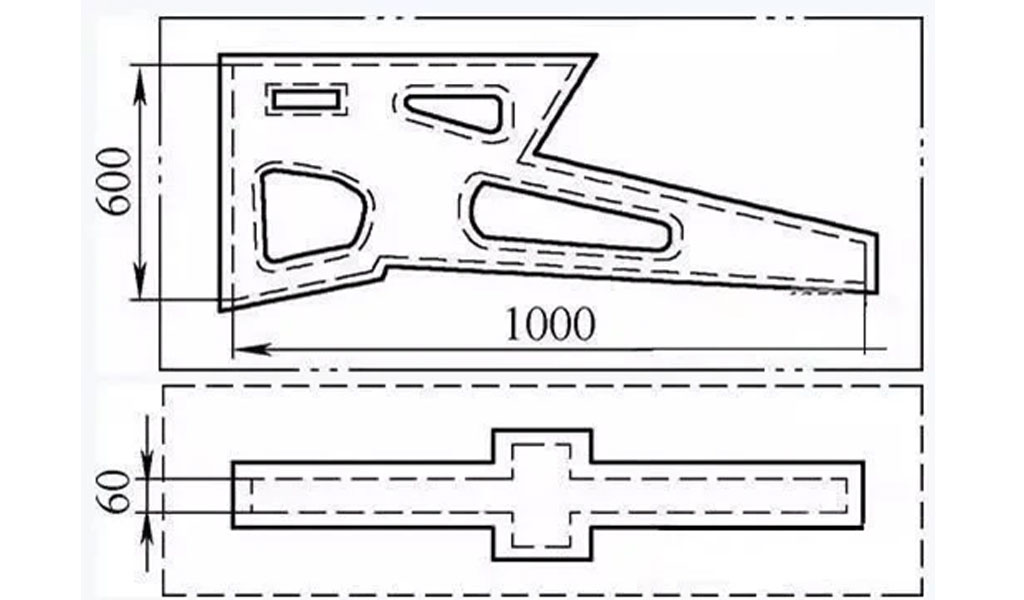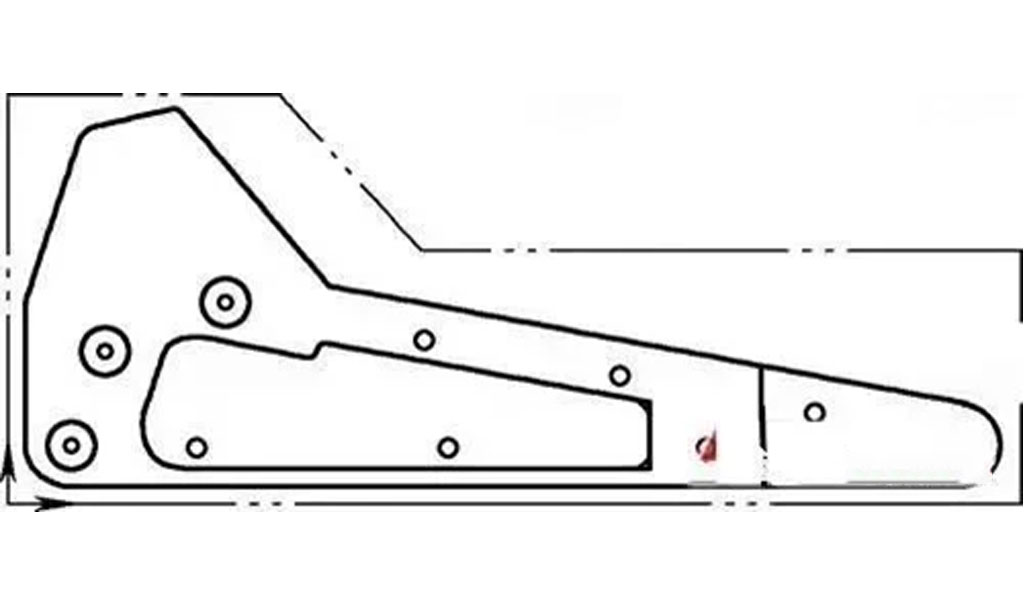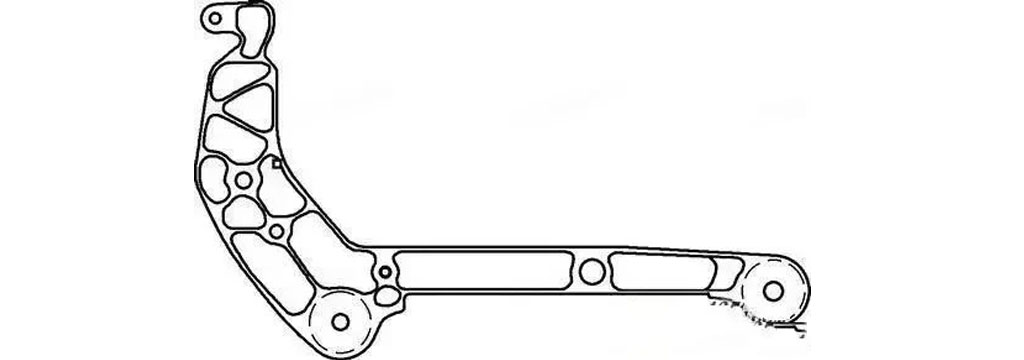
3 Processes And 6 Operations To Solve Aluminum Cnc Machining Parts Of Deformation
The Process Measures To Reduce Deformation Of Aluminum Machining
1. Reduce the internal stress of the blank
Natural or artificial aging and vibration treatment can partially eliminate the internal stress of the blank. Pre-processing is also an effective process method. For larger blanks, due to the large allowance, the deformation after aluminum precision cnc machining is also large. If the excess part of the blank is pre-processed and the allowance of each part is reduced, it can not only reduce the cnc machining deformation of the subsequent process, but also release a part of the internal stress after pre-processing for a period of time. 
For example, the picture above shows the beam part, the shape of the blank is 60kg as shown by the double-dotted line, and the part weighs only 3kg. The flatness error can be as high as 14mm if it is processed and formed at one time according to the dotted line in the figure. If the pre-processing is carried out according to the solid line in the figure, and then processed into the required parts after natural aging for a period of time, the flatness error can be reduced. to 3mm.

Parts of a certain type of cap piercer
The picture above is a part of a certain type of cap piercer, the local minimum thickness is only 3mm, and the thickness of the blank before cnc machining is 20mm. The parts can be directly processed to the size by changing the pressure plate on the machining center, but when they are removed from the worktable, the bottom ends of the parts will warp upwards, resulting in serious over-tolerance or even scrapping.

Therefore, before cnc machining, first open a stress relief groove on the blank, as shown by the solid line in Figure 3, and then remove it from the workbench, and naturally age it for 1 to 2 hours, so that all deformation occurs at this time as much as possible. After that, a fitter leveling process is added to level the part, and the deformation of the part in the subsequent cnc machining will be greatly reduced.
2. Improve the cutting ability of the tool
The material and geometric parameters of the tool have an important influence on the cutting force and cutting heat. The correct selection of the tool is very important to reduce the machining deformation of the part.
(1) Reasonable selection of tool geometric parameters.
Rake angle: Under the condition of maintaining the strength of the blade, the rake angle is appropriately selected to be larger, on the one hand, a sharp edge can be ground, and on the other hand, the cutting deformation can be reduced, the chip removal can be smooth, and the cutting force and cutting temperature can be reduced. Never use tools with negative rake angle. Relief angle: The size of the relief angle has a direct impact on the wear of the flank and the quality of the machined surface.
The cutting thickness is an important condition for selecting the clearance angle. During rough milling, due to the large feed rate, heavy cutting load, and large heat generation, the tool requires good heat dissipation conditions. Therefore, the clearance angle should be selected to be smaller. When fine milling, the cutting edge is required to be sharp, the friction between the flank face and the machined surface is reduced, and the elastic deformation is reduced.
Therefore, the clearance angle should be larger. Helix angle: In order to make the milling smooth and reduce the milling force, the helix angle should be as large as possible. Main declination angle: Properly reducing the main declination angle can improve the heat dissipation conditions and reduce the average temperature of the cnc machining area.
(2) Improve the tool structure.
Reduce the number of milling cutter teeth and increase the chip space. Due to the large plasticity of the aluminum material and the large cutting deformation during cnc machining, a large chip space is required, so the bottom radius of the chip groove should be large and the number of aluminum milling cutter teeth should be small.
Finely ground teeth. The roughness value of the cutting edge of the cutter teeth should be less than Ra=0.4um. Before using a new knife, you should use a fine oil stone to lightly sharpen the front and back of the knife teeth a few times to eliminate the burrs and slight serrations left when sharpening the teeth. In this way, not only can the cutting heat be reduced, but also the cutting deformation is relatively small. Strictly control the wear standard of the tool.
After the tool is worn, the surface roughness value of the workpiece increases, the cutting temperature rises, and the workpiece deformation increases. Therefore, in addition to the selection of tool materials with good wear resistance, the tool wear standard should not be greater than 0.2mm, otherwise it is easy to produce built-up edge. When cutting, the temperature of the workpiece should generally not exceed 100 ℃ to prevent deformation.
3. Improve the clamping method of the workpiece
For thin-walled aluminum workpieces with poor rigidity, the following clamping methods can be used to reduce deformation:
- For thin-walled bushing parts, if a three-jaw self-centering chuck or a spring chuck is used for radial clamping, once it is released after cnc machining, the workpiece will inevitably deform. At this time, the method of pressing the axial end face with better rigidity should be used. Position the inner hole of the part, make a threaded mandrel, insert it into the inner hole of the part, press the end face with a cover plate on it, and then tighten it with a nut. When machining the outer circle, clamping deformation can be avoided, so as to obtain satisfactory machining accuracy.
- When cnc machining thin-walled and thin-plate workpieces, it is best to use vacuum suction cups to obtain evenly distributed clamping force, and then process with a small amount of cutting, which can well prevent workpiece deformation.
- Use the packing method. In order to increase the process rigidity of thin-walled workpieces, a medium can be filled inside the workpiece to reduce the deformation of the workpiece during clamping and cutting. For example, urea melt containing 3% to 6% potassium nitrate is poured into the workpiece. After cnc machining, the workpiece can be immersed in water or alcohol, and the filler can be dissolved and poured out.
4. Reasonable arrangement of processes
During high-speed cutting, due to the large machining allowance and interrupted cutting, the cnc milling process often generates vibration, which affects the machining accuracy and surface roughness. Therefore, the CNC high-speed cutting process can generally be divided into: roughing-semi-finishing-corner-clearing-finishing and other processes. For parts with high precision requirements, it is sometimes necessary to perform secondary semi-finishing and then finishing. After rough machining, the parts can be cooled naturally, eliminating the internal stress caused by rough machining and reducing deformation. The allowance left after rough machining should be greater than the deformation, generally 1 to 2 mm. During finishing, the finishing surface of the parts should maintain a uniform machining allowance, generally 0.2 ~ 0.5mm, so that the tool is in a stable state during the machining process, which can greatly reduce cutting deformation, obtain good surface machining quality, and ensure Product accuracy.
6 Ways To Avoid Aluminum Deformation
In addition to improving the performance of the tool and eliminating the internal stress of the material by aging treatment in advance, in actual operation, the use of appropriate operating methods can effectively avoid the cnc machining deformation of the material.
1. Symmetrical Cnc Machining Method
For parts with large machining allowance, in order to make them have better heat dissipation conditions during the machining process and avoid heat concentration, symmetrical machining should be adopted during machining. If a 90mm thick sheet needs to be processed to 60mm, if one side is milled and the other side is milled immediately, and the final size is processed at one time, the flatness will reach 5mm; if it is processed symmetrically with repeated feeding, each side is processed twice to The final dimension can guarantee a flatness of 0.3mm.
2. Layered multiple Machining method
If there are multiple cavities on the sheet part, as shown in the picture below. When Cnc Machining, it is not suitable to use the sequential processing method of one cavity and one cavity, which will easily cause uneven stress on the parts and cause deformation. Multi-layer Cnc Machining is adopted, and each layer is processed to all the cavities at the same time, and then the next layer is processed to make the parts evenly stressed and reduce deformation. 
3. Proper selection of cutting amount
The cutting force and cutting heat can be reduced by changing the cutting amount. Among the three elements of cutting amount, the amount of back-engagement has a great influence on the cutting force. If the machining allowance is too large, the cutting force of one pass is too large, which will not only deform the parts, but also affect the rigidity of the machine tool spindle and reduce the durability of the tool. If the amount of knives to be eaten by the back is reduced, the production efficiency will be greatly reduced. However, high speed machining is used in CNC milling, which can overcome this problem. While reducing the amount of back cutting, as long as the feed is increased accordingly and the speed of the machine tool is increased, the cutting force can be reduced and the Cnc Machining efficiency can be ensured at the same time.
4. The order of the knife should be paid attention to
Roughing and finishing should use different pass sequences. Rough machining emphasizes improving machining efficiency and pursuing the removal rate per unit time. Generally, up-cut milling can be used. That is, the excess material on the surface of the blank is removed at the fastest speed and the shortest time, and the geometric contour required for finishing is basically formed. While finishing emphasizes high precision and high quality, it is advisable to use down milling. Because the cutting thickness of the cutter teeth gradually decreases from the maximum to zero during down milling, the degree of work hardening is greatly reduced, and the degree of deformation of the part is also reduced.
5. Secondary compression of thin-walled parts
Thin-walled workpieces are deformed due to clamping during Cnc Machining, and even finishing is unavoidable. In order to reduce the deformation of the workpiece to a minimum, you can loosen the pressing piece before finishing the final size, so that the workpiece can freely return to its original state, and then slightly press it, as long as the workpiece can just be clamped, so that The ideal Cnc Machining effect can be obtained. In a word, the action point of the clamping force is preferably on the supporting surface, and the clamping force should be applied in the direction of good rigidity of the workpiece. On the premise of ensuring that the workpiece is not loose, the smaller the clamping force, the better.
6. Drilling before milling
When machining parts with a cavity, try not to let the milling cutter plunge directly into the part like a drill when machining the cavity, which will result in insufficient space for the milling cutter to accommodate chips and poor chip removal, resulting in overheating, expansion, and chipping of the parts. Unfavorable phenomena such as broken knife. First drill the hole with a drill of the same size as the milling cutter or one size larger, and then mill it with the milling cutter. Alternatively, CAM software can be used to produce helical rundown programs.
Be-cu aluminum machining china prototype company service include : aluminum cnc turning, aluminum milling service, aluminum extrusions, 5 axis machining aluminum, swiss machining aluminum, aluminum guide,aluminum products